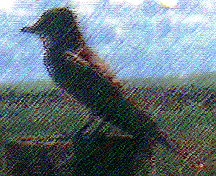|
|
| ||||||
|
| |||||||
|
October 17, 1998 |
|
octubafest | |||||
|
|
|
| |||||
Copyright © 1998, Janet I. Egan |
|
John Griffiths can do things with a tuba that transcend our feeble notion of reality. The strange thing is that neither Nancy nor I had heard of John Griffiths before this Octubafest, and we came to Octubafest to hear Gary Buttery and Alchemy whom we'd heard at the Wickford tuba festival a couple years back. The newspaper listing didn't make a big deal of Griffiths, so we had no idea what to expect. He played works by David L. McIntyre and Elizabeth Raum that just blew me away. I can't think of any other way to say it. He blew me away! I started designing a John Griffiths action figure in my head. Nancy practically ran to buy his CD when the recital was over. This guy is good! I scanned in part of the program, listing what he played. Will There Be a Time ? featured percussive effects like hitting the mouthpiece with his palm, and blowing directly into the tube without the mouthpiece. Described in words, it sounds weird. As music and as political/moral statement about the horrors of war it works dramatically. Will There Be a Time? and Secret: A Melodrama for Tuba and Tape both feature the spoken word. The recorded spoken word on Secret worked better than Griffiths' "dramatic speaking" during Will There Be a Time? but in both cases the words really added to the impact of the piece. Alchemy played some more traditional tuba pieces, medley of folk dances, classical pieces, an original piece by Gary Buttery, and of course the obligatory polka. They were excellent, skilled players and put on a polished performance. I kind of wish I'd heard them before John Griffiths, though. It was tough to return to ordinary tuba reality once we'd been taken places tubas don't usually go. But a whole afternoon of tuba music was a real treat. I wished we could make the time to stay for the evening classical concert but since we're going to see Julie's play tomorrow, I need to drive us all the way from South Kingstown to North Andover - not s short drive and best done when I'm still awake. The Griffiths recital was at 1:15 and the Alchemy concert was at like 3:30 or something so we had a little time to check out the art galleries that were in the same building as the recital hall. In the photography gallery: "Swimmers" by Christine Osinski. In the hallway gallery: "Book Pictures" by Dennis Grady. I'd seen a notice about Osinski's exhibit in the paper and was eager to see it. It did not disappoint. She photographed members of a synchronized swim team at pool side over a long period of time. The blurb at the beginning of the gallery said she rusted out two cameras doing this. They're black and white gelatin silver prints and they capture every curve and wrinkle and detail of the women's bodies down to the folds in their swimsuits. One picture of three older women in the locker room looks like the Three Graces only older and saggier and more gritty. A disembodied pair of feet on the edge of the pool (the rest of the body is under water) takes on a spiritual/symbolic quality. It definitely transcends literal depiction of a girl swimming. The women and girls in these pictures are all ages and shapes and sizes and you get a sense of thoughtful observation of their individuality and their commonality from Osinski's photos. I left wanting to see more of her work. I stumbled on Grady's "Book Pictures" lining a hallway outside the main gallery. They're dye-coupler photographs of "opaque ideological texts". The idea of photographing books intrigued me: sort of a way of photographing ideas and also viewing the book itself as an object independent of its content all at the same time. It took Nancy a few minutes to realize it was photos rather than just photocopies of text. There was something eerie about it. The books were indeed opaque and idealogical. Economic and political thought from various viewpoints but all sort of frightingly detached from living breathing human beings. Looking at the texts this way made me see how powerful ideology can be - and not necessarily in a good way. I only read a few of the texts, enough to get a feel for what Grady was looking at. I copied down a quote from Grady's explanatory material posted at the entrance to the hallway:
I went back to the concert hall feeling a definite need to have my head demagnetized. | |||||
